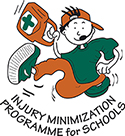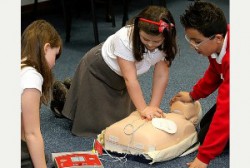PICTURE the scenario. You come out of your local Sainsbury’s with your shopping and walk back to your car. En route you see your neighbour collapsed on the floor.
What do you do?
Well, Year 6 children from Fernwood Junior School in Wollaton now know exactly what to do, thanks to a scheme called the Injury Minimisation Programme for Schools.
The programme invites ten and 11-year-old children into the A&E department at the Queen’s Medical Centre.
They are given a tour around the different areas before being shown how they should act in case of such an emergency.
When the youngsters from Fernwood had their chance, they first watched experts from the programme demonstrate what they should do with the stricken neighbour, with the aid of a dummy.
They were also put through a scenario which involved calling 999 for an ambulance as well as how to use a defibrillator.
Amardeep Bains, ten, was among the children acting out the situation.
He said: “It is really interesting and helpful. I am now confident I will know what to do if I found myself in a situation like that.”
Class teacher Esther Evans said the skills could be vital for the children.
She said: “You can’t underestimate how important it could be. It is all about helping the children understand what they could do if they found themselves in a situation like this.
“These are life skills that they are learning. If one of them goes on to save a life then it will be well worth it.”
The programme is run with the help of Nottingham City Council and Nottingham Hospitals Charity funding. Since it launched in 2001, nearly 40,000 Nottingham children have got involved.
But it is not just about saving lives in an emergency.
One of the reasons for giving the youngsters a tour of the department is to discourage them from getting into an emergency situation in the first place. It is also aimed at showing them that hospitals need not be scary places.
The children were shown a variety of medical instruments, including oxygen masks and a machine used for measuring heartbeats and oxygen levels.
They were also taken to the fracture clinic and had plaster placed around their fingers – causing a lot of excitement.
Alfie Smith, ten, said: “It feels strange having the plaster on my finger.
“It is interesting to see all of the equipment and to see what happens in A&E.”
His mum Ruth Smith, 47, was with the visiting group. She said: “It is great the children are being given a chance to learn this.
“It is reassuring as a mum to know that Alfie will now know what he should do if he is in an emergency.”
The hospital visit acts as the culmination of the programme for schoolchildren.
All schools involved have a pack, which they work through with Year 6 children throughout the school year.
Anne-Marie Lawrence, who is among the team which delivers the programme, said: “We believe that children of this age are best placed to take in the information they are given.
“It is about teaching them really important and potentially life-saving skills. The response we get from the children is fantastic.”
One schoolgirl who had been through the programme several years ago later scalded her leg by spilling a cup of tea at home.
Using the knowledge she had gained from the programme, she stayed calm and dialled 999 before getting cold water on the burns.
“By doing that she saved herself from needing skin grafts,” added Ms Lawrence.

